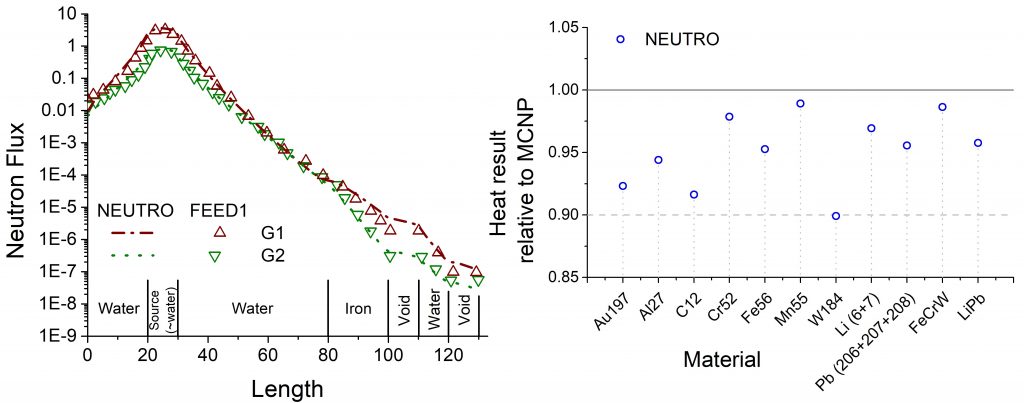
Building on the work described in our previous posts (please see links below), we have continued developing NEUTRO, the neutronics module in Alya. The latest advancements are portrayed in the article entitled “Validating NEUTRO, a deterministic finite element neutron transport solver for fusion applications, with literature tests, experimental benchmarks and other neutronic codes” that has been recently published in Plasma Physics and Controlled Fusion (PPCF).
Neutron damage to fusion reactor materials and tritium self-sufficiency are two significant challenges that need to be solved for fusion to be a viable energy source integrated with the electricity grid. The development of future fusion reactors requires a thorough understanding and the ability to predict these processes, which in turn means highly demanding simulations need to be performed to assist in the analysis of the consequences of neutrons interacting with the vast array of reactor components.
Alya is a finite element multiphysics parallel framework created and developed at the Department of Computer Applications in Science and Engineering (CASE) at Barcelona Supercomputing Center (BSC). It is designed from its conception to solve varied physical phenomena in large-scale supercomputers, achieving high parallelism standards and scalability, coupling different physics models in separate modules coded and compiled independently.
NEUTRO is the module that simulates radiation transport, solving the stationary Boltzmann transport equation. The model uses finite elements for the spatial domain, the discrete ordinates method to discretize the particle direction of flight, the multigroup approach for the energy range, and material anisotropy of the scattering medium is considered using real-based expressions for spherical harmonics.
We presented the latest developments on NEUTRO at the 2nd Fusion HPC Workshop which took place on the 2nd and 3rd of December 2021. Thereafter, we were invited to submit an article to a special issue of the PPCF journal managed by IOP Publishing (a subsidiary of the UK and Ireland Institute of Physics). Our new article is part of this special issue.
The first results included in the paper are from classic literature tests. These have served as benchmarks for other neutronic codes and comprise:
- The Reed test: a domain containing four highly heterogeneous regions, a strong absorber, a moderate absorber, a void region, and a predominantly scattering medium with two separate neutron sources.
- The Alcouffe case: four regions of varying material properties alternating zones of unit sources with sourceless areas and different scattering coefficients.
- A deep radiation penetration case: a case in which neutrons are required to permeate deep into the medium before reaching the detector, causing the perceived flux to be quite low.
- A three energy groups shielding test with anisotropic scattering: a domain representing an axial slice of a cylindrical reactor with a source surrounded by shielding sections of water, iron, and voids.
Our new paper also reports on the results from the comparisons of NEUTRO with several benchmark cases selected from SINBAD (Shielding Integral Benchmark Archive and Database), a joint project from the NEA (Nuclear Energy Agency, Organization for the Economic Cooperation and Development) and ORNL/RSICC (Oak Ridge National Laboratory, Radiation Safety Information Computational Center). Specifically, the set of experiments carried out at the OKTAVIAN facility of Osaka University, in which hollow spheres of varying sizes and different single-isotope materials with an inner DT (deuterium-tritium) source were used. The experiments aimed to study neutron and gamma-ray leakage spectra on the outer surface of the spheres.
Finally, simulations performed with NEUTRO were compared to those with the MCNP code (Monte Carlo N-Particle), currently regarded as the fusion industry standard for neutron transport simulations. A 3D layer with a thickness of 20 cm and a source in one of its faces was used considering several materials. The results include the leakage spectra on the side opposite the source and the neutron flux through the thickness of the body. Additionally, we compared the average volumetric heat calculated by both codes.

All the results included in the published article are highly satisfactory, encouraging us to further the development of NEUTRO within Alya. At the moment, more detailed results of the heat distribution over the domain are being obtained. Moreover, we are currently working on the integration of NEUTRO with other Alya modules, such as the temperature and incompressible fluids modules, to carry out multiphysics simulations on fusion reactor parts, using a neutron source that deposits energy in the domain, inducing heat in materials that interact directly with the liquid coolant.
Finally, we would like to kindly remind everyone about the upcoming 3rd Fusion HPC Workshop and extend an invitation to submit your work. Abstract submission will close on October 7, 2022, at 1 pm CEST. Participants at the Fusion HPC Workshop will gain a broad understanding of the status of fusion HPC research internationally by attending presentations by leading researchers in a broad range of topics. More information can be found on the main workshop website and the abstract submission page.
Earlier posts on NEUTRO: here and here
This work is part of the FusionCAT project with reference number 001-P-001722 that has been 50% co-financed with € 1.960.963,66 by the European Fund for Regional Development of the European Union within the framework of the 2014-2020 ERDF Operational Program of Catalonia, with the support of the Generalitat of Catalonia. In addition, it has been partly co-financed by Grant PID2019-110854RB-I00 funded by MCIN/AEI/10.13039/501100011033.

